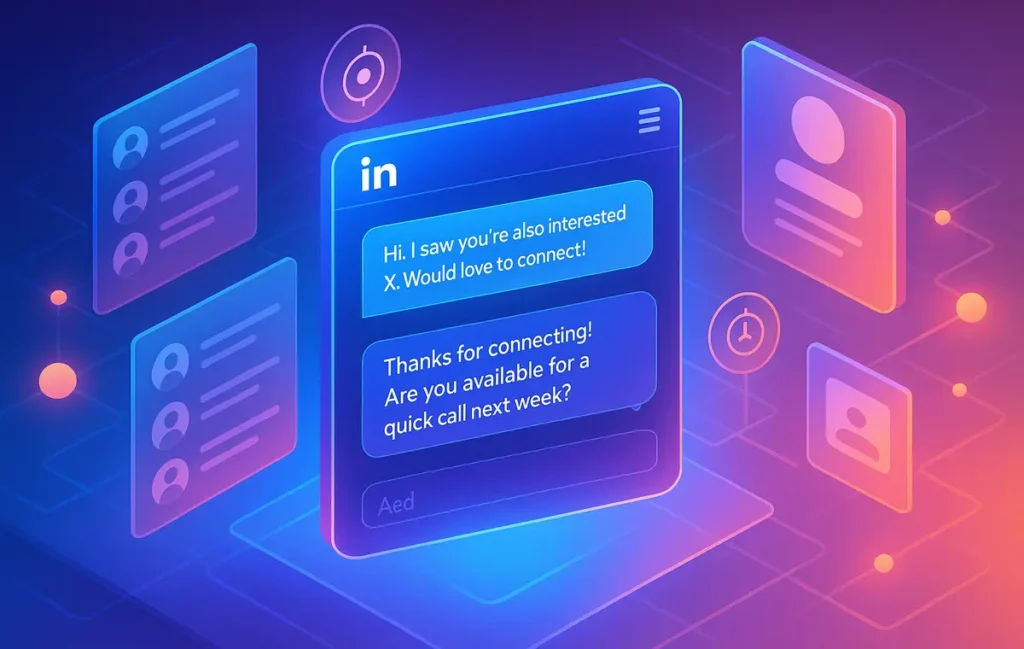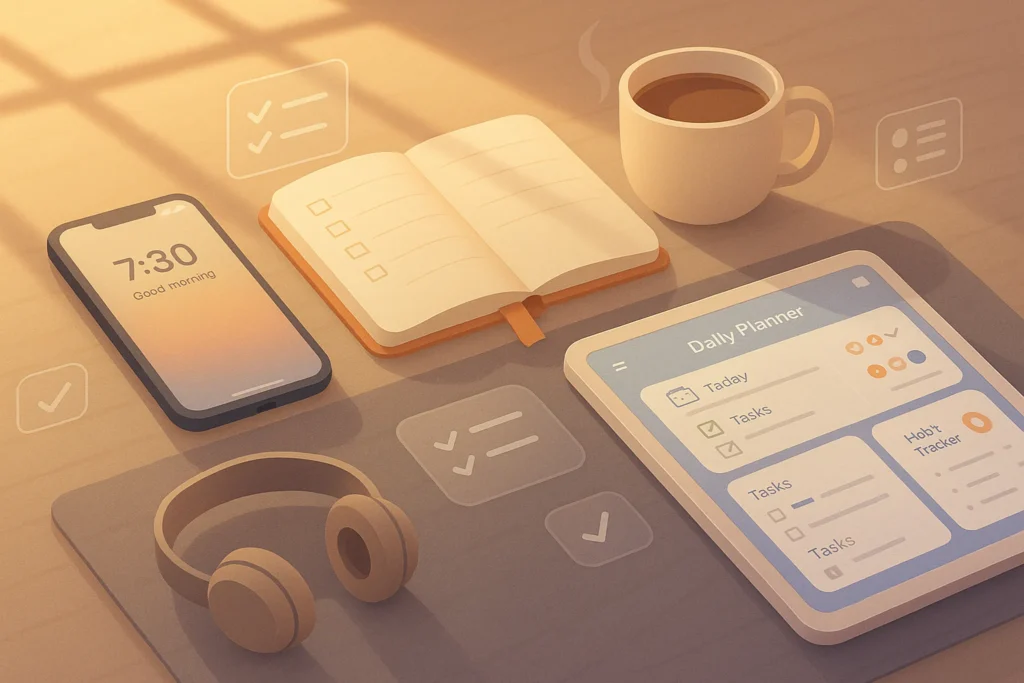🚀 Why LinkedIn Outreach Still Works—And Why Most Fail
In a world where inboxes are saturated with cold emails and DMs, LinkedIn remains the top B2B channel for building authentic business relationships. Over 65 million decision-makers actively use the platform every month, making it a goldmine for outreach if you do it right. But here’s the catch: most professionals get it wrong. They either blast generic connection requests, copy-paste templates that scream automation, or follow cadences that feel like harassment. The result? Ignored messages, low acceptance rates, and a reputation that damages their brand rather than elevates it.
At NerdChips, we’ve seen the difference between an outreach campaign that feels human and one that reeks of spam. The good news? With the right targeting, personalized icebreakers, and thoughtful cadences, you can double or even triple your response rate without adding more hours to your week.
💡 Nerd Tip: Think of outreach not as sales, but as micro-conversations that gradually build trust.
🎯 Smart Targeting on LinkedIn
The foundation of great outreach is precise targeting. No matter how well-crafted your message is, if it lands in the wrong inbox, it’s wasted effort. LinkedIn’s filters and Sales Navigator are your best allies here. Define your ICP (Ideal Customer Profile) clearly: industry, company size, job title, and even years of experience matter. Instead of sending out 500 connection requests randomly, narrow it down to 50–100 highly relevant prospects that actually fit your offer.
For example, if you’re offering content automation services, targeting “Marketing Managers in SaaS companies with 50–200 employees” is far sharper than just “Marketing professionals.” This level of granularity can boost acceptance rates from an industry average of 20% up to 45%.
Don’t overlook behavioral signals either. If someone has recently posted about scaling their sales process, they’re far more likely to be open to a conversation about automation. This aligns perfectly with insights from campaigns where marketers layered targeting with engagement signals—leading to 2.3x higher reply rates.
When you compare this approach to pure automation, the difference is stark. Fully automated outreach often falls into spam traps. Human-led targeting, however, ensures relevance and establishes credibility before the first message is even sent.
💬 Crafting Icebreakers That Work
Here’s where most outreach dies: the opening line. A generic “Hi, I’d love to connect” is the equivalent of small talk at a networking event—it gets forgotten instantly. A great icebreaker acknowledges context, relevance, and shared ground.
Start by referencing something meaningful. Maybe they wrote a LinkedIn post last week about AI marketing tools. A simple: “I saw your post on AI workflows—your point about ROI measurement really hit home. Curious, have you tested any RPA tools yet?” immediately sets you apart from the crowd.
Personalization doesn’t have to mean long research sessions. Mentioning a mutual connection, reacting to their content, or even pointing out a common challenge in their industry can be enough. Studies have shown that even light personalization increases reply rates by 32%.
💡 Nerd Tip: Don’t overdo flattery—it often backfires. Instead, show you’ve genuinely engaged with their perspective before making your ask.
🔁 Building Outreach Cadences That Convert
Outreach isn’t a single shot—it’s a sequence. A well-designed cadence respects the recipient’s time while building familiarity. Think of it as a series of nudges rather than a barrage of pitches.
A proven cadence looks like this:
Message 1 (Connection request): Short and relevant, no pitch. Just context for why you want to connect.
Message 2 (Icebreaker): Once accepted, engage with something they care about. Mention their content, industry trend, or a shared interest.
Message 3 (Value add): Share an insight, a case study, or even a free resource. It should feel like you’re contributing to their world, not extracting.
Message 4 (Soft ask): Suggest a low-pressure next step, like a quick 15-minute call, framed as an exchange rather than a sale.
Spacing matters. A good rhythm is 3–5 days between each message. Too close together feels desperate, too far apart makes you forgettable. Data from B2B sales teams shows that 4–5 touchpoints spread over 21 days tend to perform best.
🚫 Avoiding Spam Traps
LinkedIn users are savvier than ever, and spammy behavior gets punished quickly. If your connection note looks like a template, or if you pitch immediately after connecting, you’ll trigger red flags. LinkedIn’s algorithm even downgrades accounts that get too many ignored requests.
Avoid overusing sales-heavy language like “exclusive offer,” “limited time,” or “guaranteed results.” These phrases may work in ads but will tank your credibility in a direct message. Be mindful of automation tools that blast hundreds of invites per day—they not only risk your account but also kill authenticity.
This is where a hybrid approach—using light automation for organization but keeping the messaging human—outperforms both extremes. Our earlier deep dive into Automating LinkedIn Outreach Without Spam breaks down how to strike that balance.
🛠️ Tools That Support Outreach (Without Killing Authenticity)
While the heart of outreach is human, the right tools can streamline your workflow. LinkedIn’s native search and Sales Navigator remain the backbone for targeting. Crystal Knows is an underrated gem—it uses personality insights to suggest how to phrase your outreach based on DISC profiles.
Expandi, while technically an automation tool, can be used responsibly. Instead of blasting thousands of requests, set it to help you manage small, segmented campaigns while keeping the messages personalized. The key is not letting tools replace your voice.
For marketers who want broader support, combining outreach tools with systems like CRM vs. Marketing Automation platforms ensures you track conversations across channels without losing the human touch. NerdChips has tested campaigns where a light touch of tech lifted reply rates by 15%, but over-automation caused a 40% drop. Balance is everything.
📊 Case Study: A Humanized Outreach Campaign in Action
A SaaS founder targeting mid-sized eCommerce companies wanted to secure 10 demo calls per month. Instead of blasting generic requests, he narrowed his audience to “Ecommerce Operations Managers in the US with 3–10 years of experience.”
His cadence followed the four-step approach outlined earlier. The connection request acceptance rate was 47%. His second message, referencing a recent LinkedIn post about supply chain challenges, got a 32% reply rate. By the end of the campaign, he booked 14 demo calls in just three weeks, exceeding his target by 40%.
What stood out? Every message felt like it came from a peer, not a salesperson. That’s the essence of humanized outreach—relevance, context, and patience.
⚡ Want to Master LinkedIn Outreach?
Check out trusted outreach tools like LinkedIn Sales Navigator, Crystal Knows, and Expandi. Use them wisely to stay human—while still scaling your results.
🧠 The Psychology of Outreach
At its core, outreach is less about tactics and more about psychology. Human beings are wired to respond to messages that feel personal, relevant, and respectful of their time. When a LinkedIn message taps into these triggers, it immediately stands out from the noise.
One powerful principle is reciprocity. If you give value before asking for anything, the other person feels a subconscious pull to reciprocate. This could be as simple as sharing an article that addresses their problem or commenting on their post with a thoughtful perspective. Neuroscience studies show that small acts of giving can activate the brain’s reward centers, creating a positive bias toward the sender.
Another psychological angle is cognitive load. Long, complex, or jargon-filled messages overwhelm the brain and reduce response rates. That’s why messages under 300 characters often outperform lengthy pitches by 27%. Clarity, brevity, and relevance reduce friction and make it easier for the recipient to engage.
💡 Nerd Tip: Think about outreach as “mental energy management.” The easier you make it for someone to say yes, the higher your reply rate climbs.
📊 Outreach Metrics & Benchmarks
Numbers don’t lie, and benchmarks give you a reality check on whether your outreach is working. Across LinkedIn, the average connection acceptance rate hovers between 20–25%. This means that out of every 100 connection requests, only about a quarter typically go through.
But with precise targeting and personalized notes, campaigns often see acceptance rates jump to 40–45%. Similarly, the average reply rate for cold LinkedIn messages is just 10–15%. That’s the baseline. If your campaign is consistently hitting 25–35%, you’re already outperforming most professionals.
The key metric to monitor isn’t just replies, but positive replies—messages that indicate genuine interest. In high-performing outreach campaigns, positive reply rates sit between 8–12%, which is strong enough to fill most sales pipelines sustainably.
Tracking these metrics over time also tells you where your bottleneck is. Low acceptance rates? Your targeting or connection note is off. Low reply rates? Your icebreaker or value proposition needs work. Numbers give you the diagnostic lens to continuously refine.
❌ Mistakes to Avoid in LinkedIn Outreach
Even experienced professionals fall into common traps that tank their outreach. The first is pitching too early. Asking for a call or demo in your very first message is like proposing marriage on the first date—it’s awkward and kills trust instantly.
Another major mistake is sending walls of text. Messages that run longer than 300–350 characters drop off sharply in response rate. Prospects simply don’t have the patience to read essays in their LinkedIn inbox. Think clarity, not volume.
There’s also the issue of poor personal branding. If your LinkedIn profile looks incomplete, generic, or overly salesy, prospects won’t take your outreach seriously. A missing profile picture or a vague headline like “Business Consultant” reduces authority. Remember: before people reply, they check your profile.
Real-world complaints back this up. As one user on X recently wrote: “I get 20 LinkedIn pitches a day. 19 of them are copy-paste templates. Instant delete.” This shows that audiences are alert, skeptical, and tired of spammy approaches. Standing out requires avoiding these traps.
👤 Profile Optimization Before Outreach
Your LinkedIn profile is your silent salesperson. Before anyone replies to your message, they’ll scan your headline, summary, and recent activity. If it looks weak, no outreach strategy will save you.
Think of your profile as a landing page. Your headline should clearly state who you help and how. For instance, “Helping SaaS teams scale lead generation with AI tools” is far more compelling than “Business Development Specialist.” Your profile picture should be professional and approachable, not a cropped vacation shot.
The “About” section should focus on value-driven storytelling. Instead of listing your job history, show how you solve problems for people like your prospect. Adding recommendations, featured content, and recent posts also signals authority and builds trust.
💡 Nerd Tip: Optimize before you outreach. A polished profile can increase acceptance rates by up to 30% because it reassures prospects you’re credible.
🌐 Advanced Layer: Social Proof & Content Engagement
Outreach doesn’t start with a message—it starts with presence. Engaging with your prospect’s content before you send a connection request creates recognition and trust. A like or thoughtful comment on their post plants your name in their mind, making your outreach feel familiar rather than cold.
This pre-engagement phase can last just a week, but it significantly boosts results. Campaigns that incorporated content engagement before outreach saw reply rates rise by 50% compared to direct cold outreach. It’s the digital equivalent of shaking hands before starting a conversation.
Social proof also matters. When prospects see you actively sharing content, commenting intelligently in industry discussions, or being endorsed by mutual connections, your credibility skyrockets. Outreach is no longer from a stranger—it’s from a peer they already recognize.
💡 Nerd Tip: Outreach is 10x easier when people already know your name. Show up in their feed before you show up in their inbox.
Want More Smart Outreach Tips?
Subscribe to the NerdChips newsletter for weekly deep dives on outreach strategies, AI tools, and growth hacks—delivered straight to your inbox.
No spam. Just actionable insights and pro tips from NerdChips.
🧠 Nerd Verdict
Successful LinkedIn outreach isn’t about volume—it’s about resonance. The pros know that a handful of hyper-relevant, humanized conversations beat thousands of ignored cold pitches. By combining sharp targeting, authentic icebreakers, and respectful cadences, you create a system that feels organic while still being structured.
The bottom line? Treat every LinkedIn conversation as the start of a relationship, not a transaction. That mindset shift alone can change your outreach results forever.
❓ FAQ: Nerds Ask, We Answer
💬 Would You Bite?
If you could double your LinkedIn reply rate, what’s the first thing you’d change in your outreach?
Crafted by NerdChips for creators and teams who want their best ideas to travel the world.



